Amrita Kulkarni: Let’s talk about Transportation Alternatives. Could you give me an overview of your organisation and its work?
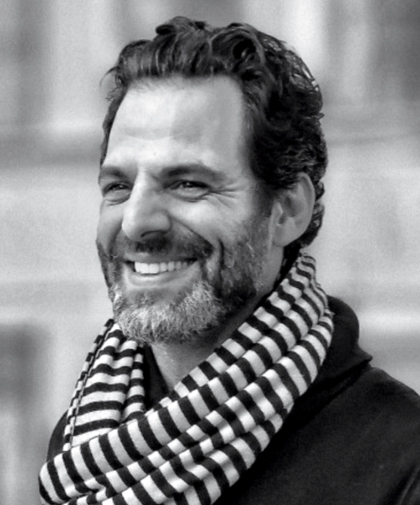
PIC SOURCE: LINKEDIN
Danny Harris: I think about our work through the lens of connection. What are the ways we can connect meaningfully as humans, and where do these connections happen? I look at the public realm as the largest space and the biggest opportunity for this. It was true all the way back at the agora (central public space) in Greece and it remains true today across our plazas and public spaces.
As an organisation, we centre the need for such space, especially in this moment when people are increasingly online and living via avatars. We believe these are the kind of spaces where we engage with others — especially those who aren’t like us — to start conversations and remain curious.
Transportation departments across our cities are one of the largest holders of real estate; they can unlock tremendous opportunity not just relating to how we move around, but also about what else that space can be utilised for. They have the potential to move us out of being beholden to cars forever.
Transportation Alternatives as an organisation is 50 years young today. Our team works across advocacy, research, fundraising and operations. We work alongside Families for Safe Streets, a group we incubated, which supports those who’ve been injured or killed in traffic violence.
What does Slow Mobility mean to you? What are some paradigms it presents?
I start with people’s perception, which is that mobility is broken. Whether you’re in a bus stuck in traffic or you have no sidewalks outside your home and nowhere to walk to — it’s the sense that these systems are broken, underinvested and not appreciated. As a result, it creates an undignified, inequitable and unsafe experience for people who are trying to get around without a car. Add in a car, and you’re now spending $10,000 a year in car payments with your life wasting away in traffic.
Even the word slow from Slow Mobility doesn’t necessarily carry positive connotations, especially in a place like New York, where everything is fast and you’re encouraged to keep up. I think the notion of slow can also mean deliberate, mindful, thoughtful and with care. It can be something that ultimately supports your own betterment, because when you slow down, you can not only smell the roses, but also appreciate where you’re at.
I remember giving a lecture back when I lived in Silicon Valley about speed limits, and how when we reduce speed it makes it safer for everybody. Later, an engineer working on building cars came up to me to say that it is irresponsible to advance this idea because these machines — cars — are built to be precise and to move quickly; by introducing barriers and reducing speed limits, we would be hindering the power of these machines!
I think that since transportation is viewed as a right in our cities, speed, as a central part of it, is tragically also viewed as a right. There is a lot of complexity at play when it comes to the construct of fast and slow in the context of transportation and mobility. Instead, we should focus on safe, accessible, affordable, dignified and, even, wonderful.
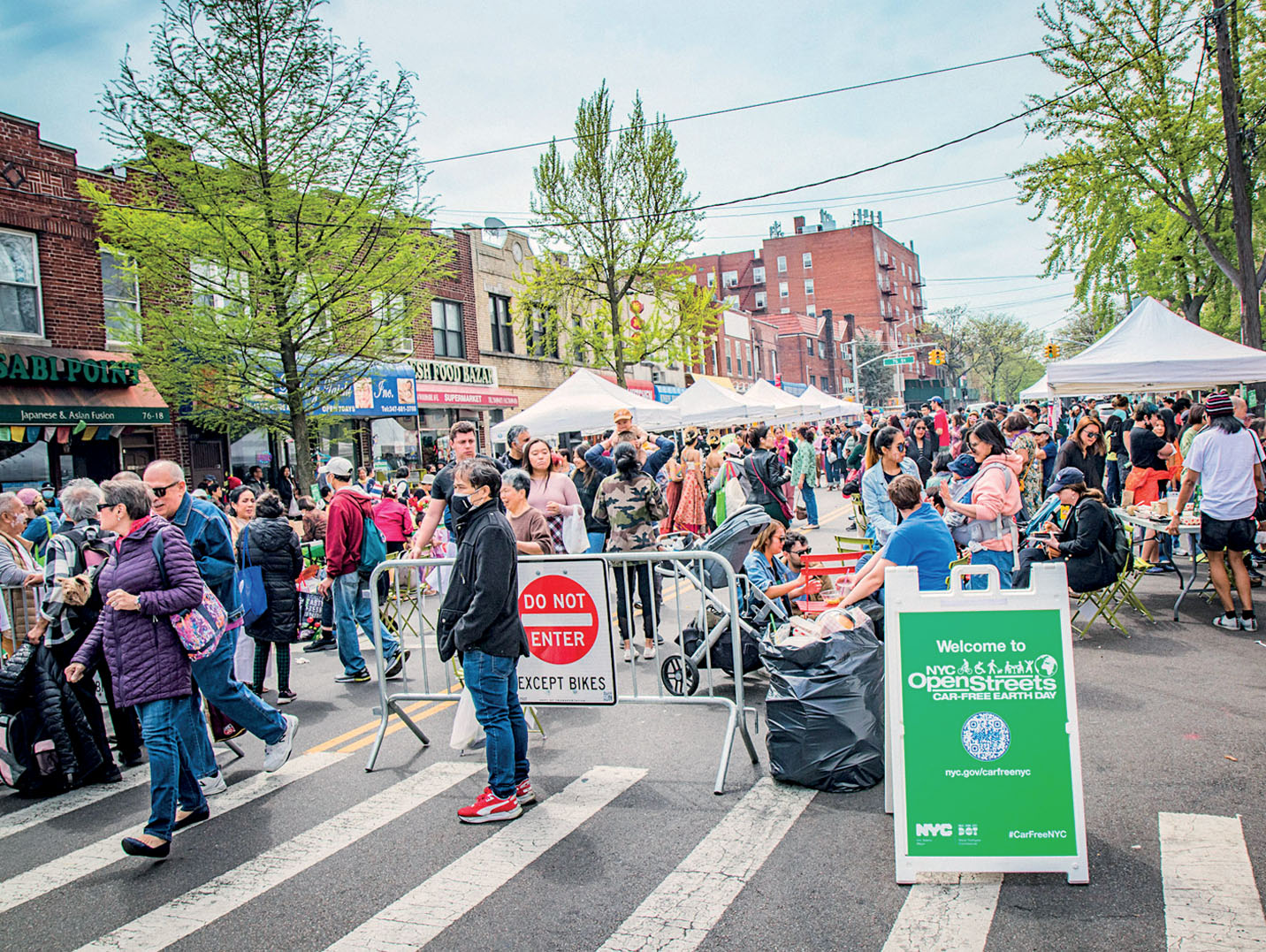
What do you see as the promise of Slow Mobility?
Walking has always been a crucial way to get around. I’m even watching my youngest kid preparing to walk and that first step as a child is not only an opening of the door to independence but also a significant parental milestone. It unlocks freedom and imagination, and a milestone we’re so proud to share with others.
But we disconnect that progress from the built environment, right? If you begin to walk, where can you walk to? Do you actually live in a community with sidewalks? And once your child starts to ride a bike, it is seen as a gift, but what happens when there are no protected bike lanes around where you live? In such cases, our cities are taking away your child’s newfound freedom. As they grow older, you’d love for them to walk to school but they can’t, because it’s not safe. You’d like for them to take public transit, but there may be no system waiting for them. A bike could take them to school, but the roads are too dangerous. So, what’s ultimately left as an option? A car, which adds a financial burden on every family, and takes away independence from kids and parents. And here we have it: instead of our cities giving people the freedom of mobility, it is giving them burdened mobility.
The car — the thing that was once sold as a right is now a burden: because you need it to get everywhere. You sit there white knuckled, holding your steering wheel as you’re inching your way through traffic. Every day, we all live the lie sold by Henry Ford when he claimed that the car represents freedom of movement, driving human progress. It may drive progress, but our cities and residents are paying the price for several things at once: financial debt, polluted air and the murder of our once-rich public transit by the automobile industry and its peers.
Whether you’re in a bus stuck in traffic or you have no sidewalks outside your home and nowhere to walk to — it’s the sense that these systems are broken, underinvested and not appreciated
How does Transportation Alternatives approach Slow Mobility initiatives? What have been some successes and the associated impact?
Over 50 years, Transportation Alternatives has worked to change the paradigm of what our streets look like, from helping build the first protected bike lane to advancing big ideas like congestion pricing. We’re at the forefront of bold ideas that take root in New York and subsequently grow elsewhere around the country.
But the other thing we work on is the mindset. How do you invite people to have a different version of what a city should be? Even something as simple as asking to put people – and not cars – first on our streets is a simple but incredibly complex idea. We’ve been trained for over 100 years to believe that cars are freedom and that cities should be built for cars. As such, human life and human needs are placed last.
We work to remind everyone that, one, people should have options to get around, and while a car can be one of those options, if it’s the only one then the city has failed you. Two: we remind people that our city can be quite simply so much more wonderful, equitable, sustainable and resilient when we give space back to people. We help advance programmes like Open Streets or Open Restaurants, where street space is taken from cars and given back to people for play or dining or recreation. In particular, the Open Restaurants programme saved 100,000 jobs during Covid by allowing restaurants to repurpose parking spaces for outdoor dining.
This is public space at its best: when it’s not just utilised to store or move inanimate objects, but rather where trees and gardens are planted, community comes together and other positive outgrowths are supported. This is when we can think about asphalt as an asset instead of just a liability.
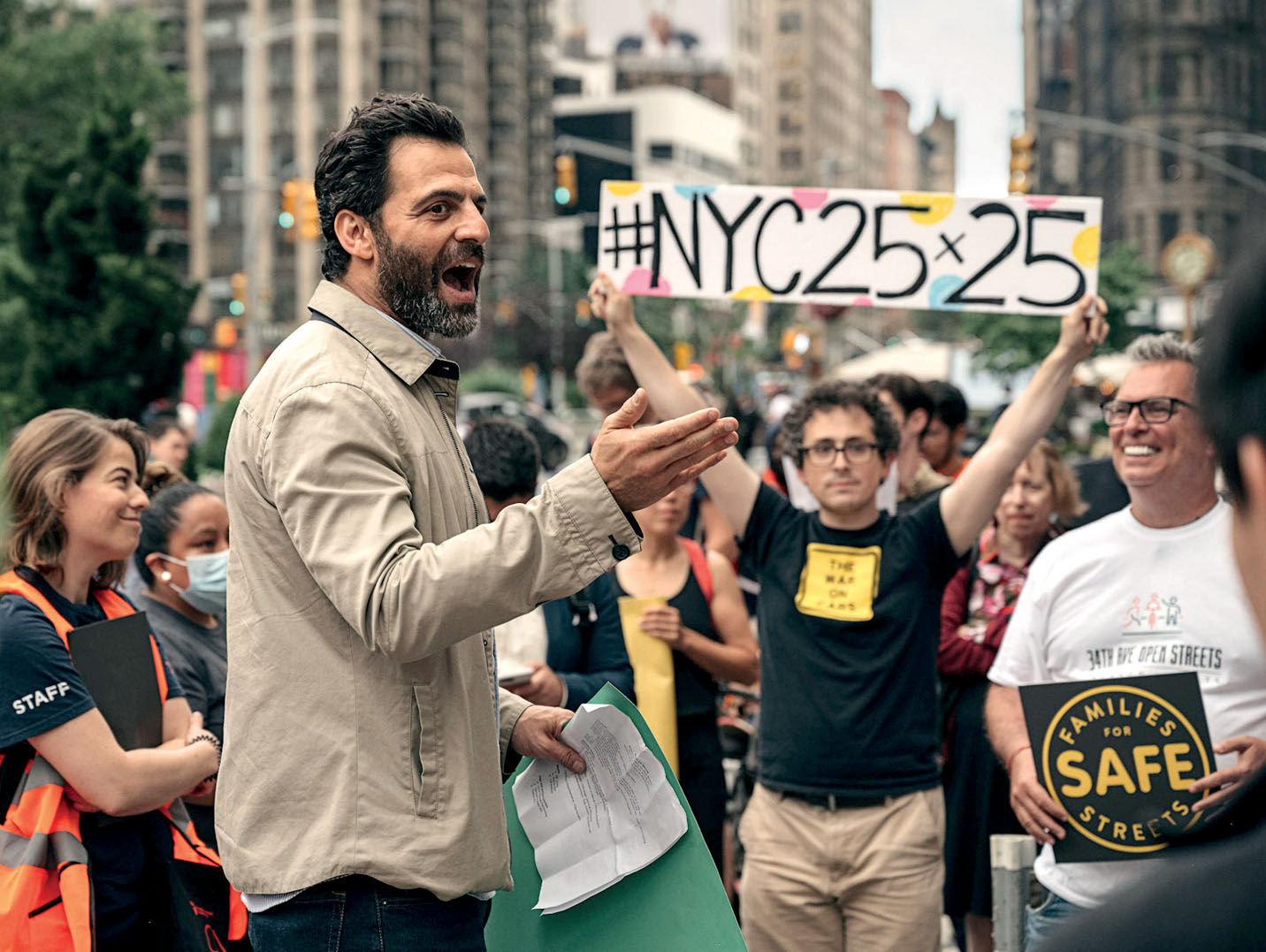
Could you share a recent project your team is working on?
I would say the most ambitious thing we’ve advanced recently is called NYC 25 x 25. Ahead of the recent mayoral election, we advanced a really bold agenda based on polling and with over 200 partners across the city, calling for the new mayor to repurpose 25% of the city’s street space.
Right now, 76% of all the public space in New York is devoted to the movement and storage of vehicles. If we could make an impact at that scale, it would mean having more than 13 Central Parks’ worth of new space made available in New York. This would mean that everybody could live within a quarter mile of a protected bike lane, a protected bus lane and a green space. It could reframe today’s piecemeal approach to neighbourhoods and offer resources rooted in space all across the city. Doing so would also get us to Vision Zero, which means no traffic fatalities.
As we built this out, we had the then mayor and six other candidates immediately embrace it. The challenge in doing this work, as you can imagine, lies in implementation. You can have people do studies, share ideas, and claim support all day long, but delivery in a complex ecosystem like New York can pose staggering challenges. Here boroughs, neighbourhoods and even streets view themselves as their own island, while literally being on different islands — and implementation quickly gets multilayered and complex.
To stay true to the needs of different communities, we identified exactly what uses there could be for additional space, should they have access to it. In some places, schools needed more space for pick up/drop off or outdoor classrooms. Groups working on sustainability needed more space for trees, or bio swells, or outdoor gardens. In the end we were able to present a series of options for reclaimed space across communities and then let them determine what works best for them as an added community benefit.
Once your child starts to ride a bike, it is seen as a gift, but what happens when there are no protected bike lanes around where you live?
What have been some of your learnings and revelations along the way?
One of our recent learnings relates to how rooted a lot of these issues are with ongoing culture wars. What we’re talking about are straightforward issues of safety and mobility, but today they’ve been elevated to a level that’s downright toxic. Discussions these days move these topics away from whether or not a street is safe to whether this is a partisan issue and whether it is your God-given right to drive a Cybertruck and park for free. The goal of our nation and every neighbourhood should be aligned on streets that are safe whether you’re walking your kids to school or driving to work.
Then there is the challenge of working with communities, because there are several paradigms at work. Think about it: a fire department doesn’t go to a community and ask, “Do you want a fire station?”, or “Where should the fire hydrants be?” They just build them because there’s an expectation that if there’s a fire anywhere in New York, they need access, and everyone should be covered equally. Same with a police station: they don’t go to a neighbourhood and say, “Do you want police presence here?”
But when it comes to safe streets and transportation, we allow very loud community voices — even a veto — over street improvement projects. Why is that? We have entire departments of transportation capable of looking at data and best practices, and designing for better outcomes. But if we start with the whole effort becoming a referendum instead of simply sharing a non-negotiable safety target, we’re all losing. It might be preferable to simply declare, “We’re going to make treatments to this street intersection to boost safety for everyone”, and then negotiate on the nuances of how many trees, or how much community furniture, or decide between bike lanes or charging stations. This would be an interesting and more useful way of bringing in the community.
What have you identified as key methods or tools for success? What works?
One is that people have to see it to believe it. So, depending on where you live, being able to see change could mean you have to travel to it, whether it’s in the same neighbourhood, city or state or across the ocean. Nothing works like success and being able to bring people to view these models — whether they’re pilots or system-wide rollouts of a new initiative — especially when they show how people can move around, how businesses continue to thrive and how giving people access to new tools not only makes a city safer but also provides an abundance of opportunities.
The road to success also requires political will, and political leadership to declare these initiatives as a key part of their agenda. Whether it’s in Chicago or New York or Boston or San Jose, and “whether it’s about creating a more equitable city, a kid friendly city, a family friendly city or a green city, it comes down to making this goal the centerpiece of a political agenda.”
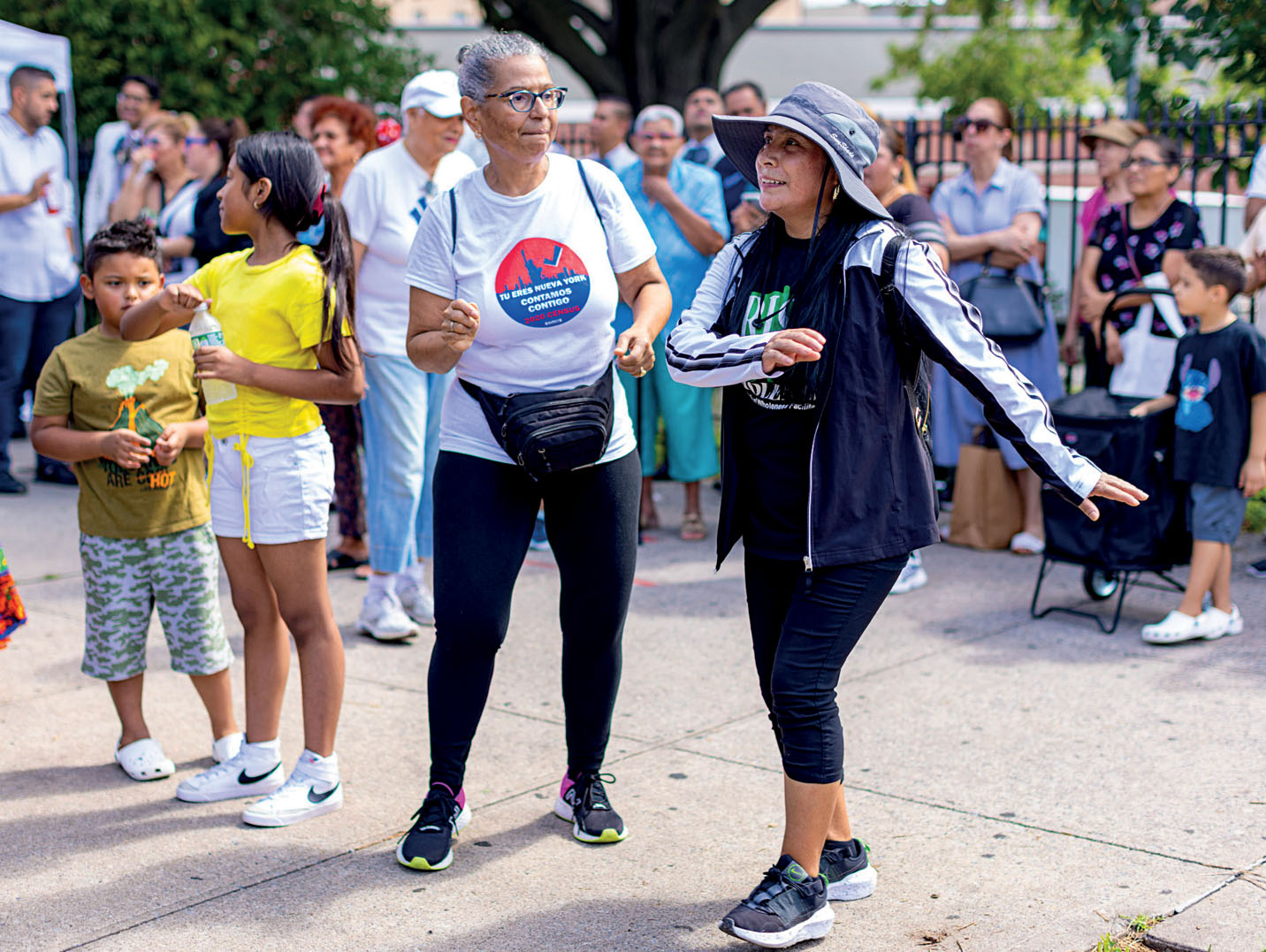
What kinds of interactions and tools does the organisation deploy with city residents?
I’m really fortunate to have an incredibly talented research team. Because of it, we are able to build tools that are first in the country, like for example Spatial Equity, which we’ve launched with MIT.
Spatial Equity is an open-source digital tool that helps people see how decisions made around public space impact their environment, infrastructure or health outcomes on their block. You can look up levels of childhood asthma or bus frequency at a community level and compare that to other places around the city. The overall goal is to be able to construct a narrative around events, like traffic crashes. The tool could help us realise that perhaps the site of the car crash was also the location with the highest levels of childhood asthma and one of the lowest levels of tree coverage in the city. And that is no coincidence.
Research from our team is driving a lot of our work. And, we also continue to be a grassroots organisation: we have committees across the boroughs and we do deep listen with partners, activists and volunteers on the front lines, launching and leading campaigns. Our goal is never to be reactive after avoidable incidents like car crashes, but when they do occur, we mobilise and do vigils, rallies, call for a set of demands around those locations, and so on. We do text-based campaigns, have a field team that does canvassing to meet people, get their feedback and welcome them into advocacy. All in all, we utilise a variety of tools to meet people where they are while centering safety in everything that we do — always listening to the voices and needs of the community.
The goal of our nation and every neighbourhood should be aligned on streets that are safe whether you’re walking your kids to school or driving to work
Let’s zoom out for a bit and talk about what inspires you and the team. What have you seen beyond NYC that you’d like to see implemented in your backyard?
I’m most inspired by Systems Thinking in other cities. For example: in Amsterdam, back in the 1970s, you had Stop de Kindermoord where the community started to gather in the aftermath of children dying, and using that terrible prompt as a tool to reimagine streetscape. In Copenhagen, it was about Jan Gehl and public life, the idea that you build places for people, and centering that aspect in everything. Paris is now centering around the idea of sustainability. These organising principles in some ways are more helpful to me than looking at a street treatment in Taipei or Bogota.
In the absence of a larger organising system, minor treatments are like sticking band-aids on a critically injured patient. All of us have a responsibility to look at both the small and the big pieces, but we need to ultimately keep our focus on what the big vision is, and how these pieces come together. This is what I’m looking for across American cities. Who are the mayors actually advancing big bold agendas that allow for reimagining our streets as a centerpiece for a large, holistic vision for a place?
Another interesting city to look at is Tirana, Albania, which is centering itself to be one of the most kid-friendly cities in the world. The way the mayor has built out that platform has been wonderful, recognising the fact that cities are places where families want to grow and thrive.
Similarly, the work of Gil Penalose from Colombia shows how when you design a city to be good for an 8-year-old as well as an 80-year-old, it’s good for everybody. The Curb-Cut Effect described by Angela Glover Blackwell at PolicyLink speaks to the same ideas and systems. When we implement these on a broader scale, that is when all the pieces that we care so deeply about become wonderfully inevitable. Because you can’t get to a more sustainable, equitable, kid-friendly and safe city without addressing them all together. It’s not just about making the streets safe, but giving people options and helping everyone thrive.
How does one get to a clarified vision or clear guiding principles? What role do you play in getting there?
Our role is twofold: first, it’s our job to help advance a vision with voices from around the city, to present what’s possible for residents as well as elected leaders. Second, our task is to actually focus on the details — get in the trenches — fight for that protected bike lane, elevate voices, involve people in advocacy, and so on. In that sense, our role can be both at the 30,000-feet level, while presenting vision and such, but also at the 3-inch level, talking about advancing daylighting near a specific intersection. Sometimes this means you can get altitude sickness going back and forth, but that’s really our job.
Lastly, I’ll say that our job is to not have a job. Right? There are well-known best practices and ideas out there that don’t need advocates or researchers or special incentives for adoption. It shouldn’t be controversial to say that every intersection should be safe, but today’s reality is that it is. We’re also at the forefront of a new transportation revolution, which may not at all be about slow mobility, but rather ‘smart’, or non-human-centered mobility, with automatic vehicles and their evolutions.
If we don’t get it right this time around, we certainly haven’t in the past 100 years. We’re at the forefront of losing the next 100-year battle. It’s essential that we not only fight, but also really centre people back in cities. If not, we’re in for a lot of trouble with engineers programming AVs, and AVs getting smarter and smarter because they aren’t going to make these human-centered decisions for us. And, the track record remains that their ‘smart decisions’ just amplify the challenges from the past whether traffic congestion or racial bias or rising income equality. But we have a chance to change that, and we must for the future of our cities and our kids.
All Photos Courtesy: Transportion Alternatives


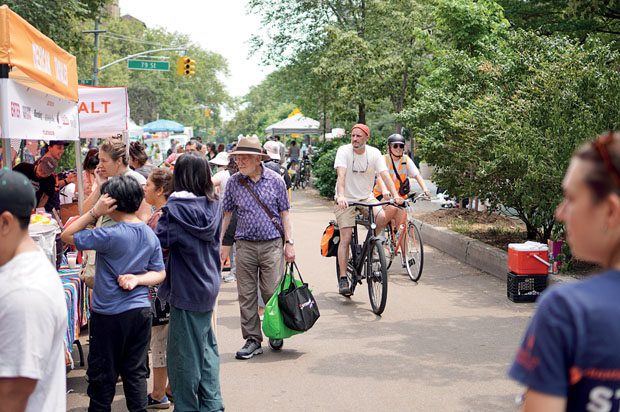

Comments (0)